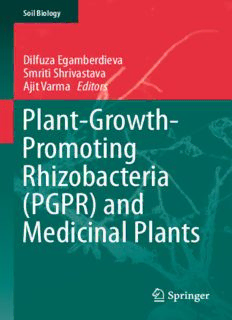
Plant-Growth-Promoting Rhizobacteria (PGPR) and Medicinal Plants PDF
Preview Plant-Growth-Promoting Rhizobacteria (PGPR) and Medicinal Plants
Soil Biology Dilfuza Egamberdieva Smriti Shrivastava Ajit Varma Editors Plant-Growth- Promoting Rhizobacteria (PGPR) and Medicinal Plants Soil Biology Volume 42 Series Editor Ajit Varma,Amity Institute of Microbial Technology, Amity University Uttar Pradesh, Noida, UP, India More information about this series at http://www.springer.com/series/5138 Dilfuza Egamberdieva (cid:129) Smriti Shrivastava (cid:129) Ajit Varma Editors Plant-Growth-Promoting Rhizobacteria (PGPR) and Medicinal Plants Editors DilfuzaEgamberdieva SmritiShrivastava DepartmentofBiotechnologyand AjitVarma Microbiology,FacultyofBiology AmityInstituteofMicrobialTechnology andSoilScience (AIMT) NationalUniversityofUzbekistan AmityUniversityUttarPradesh Tashkent,Uzbekistan Noida,UttarPradesh,India ISSN1613-3382 ISSN2196-4831(electronic) ISBN978-3-319-13400-0 ISBN978-3-319-13401-7(eBook) DOI10.1007/978-3-319-13401-7 SpringerChamHeidelbergNewYorkDordrechtLondon LibraryofCongressControlNumber:2015931076 ©SpringerInternationalPublishingSwitzerland2015 Thisworkissubjecttocopyright.AllrightsarereservedbythePublisher,whetherthewholeorpart of the material is concerned, specifically the rights of translation, reprinting, reuse of illustrations, recitation,broadcasting,reproductiononmicrofilmsorinanyotherphysicalway,andtransmissionor informationstorageandretrieval,electronicadaptation,computersoftware,orbysimilarordissimilar methodologynowknownorhereafterdeveloped.Exemptedfromthislegalreservationarebriefexcerpts inconnectionwithreviewsorscholarlyanalysisormaterialsuppliedspecificallyforthepurposeofbeing enteredandexecutedonacomputersystem,forexclusiveusebythepurchaserofthework.Duplication ofthispublicationorpartsthereofispermittedonlyundertheprovisionsoftheCopyrightLawofthe Publisher’s location, in its current version, and permission for use must always be obtained from Springer.PermissionsforusemaybeobtainedthroughRightsLinkattheCopyrightClearanceCenter. ViolationsareliabletoprosecutionundertherespectiveCopyrightLaw. The use of general descriptive names, registered names, trademarks, service marks, etc. in this publicationdoesnotimply,evenintheabsenceofaspecificstatement,thatsuchnamesareexempt fromtherelevantprotectivelawsandregulationsandthereforefreeforgeneraluse. While the advice and information in this book are believed to be true and accurate at the date of publication,neithertheauthorsnortheeditorsnorthepublishercanacceptanylegalresponsibilityfor anyerrorsoromissionsthatmaybemade.Thepublishermakesnowarranty,expressorimplied,with respecttothematerialcontainedherein. Printedonacid-freepaper SpringerispartofSpringerScience+BusinessMedia(www.springer.com) Foreword The editors of the volume “PGPR and Medicinal Plants” asked me to write the Forewordtothisbook.Ihavegonethroughthevolumecontentsandsomechapters, whichpromptedmetowritetheForeword.Microorganismsareabundantlydistrib- utedinthesoil,rangingfrombacteria,actinomycetes,fungi,algae,cyanobacteria, and protozoa. These microbes contribute many beneficial elements, like carbon, sulfur,phosphorus,andnitrogen,tothesoilbytakingpartinthenutrientcycle.The zoneofcontactbetweentherootandsoilistherhizosphere.Thisregionhasintense activity and concentration of microbes and is considered vital for plant vigor and full development to maturity. Plant growth and development promoting rhizobacteria (PGPR) are present in the vicinity of the root system and at times adhering to the root. Such bacteria have been applied to a wide range of agricul- turally important crops for the purpose of plant growth promotion, including emergenceseedgerminationandvalueaddition. The influence of root exudates on the proliferation of soil microorganisms around and inside roots as well as interactions between soil microorganisms, rhizosphere colonies, and plant hosts have been widely studied. Studies based on moleculartechniqueshaveestimatedabout4,000microbialspeciespergramofsoil samples. Powerful methods of estimation provide only the crudest measure of its magnitude.Nonetheless, manysuchestimatesexist,suggestingthatasinglegram of soil may contain over 10 billion microbial cells and more than 1,800 bacterial species(Zhangetal.2008). PGPRs are well established tocolonize plant roots and stimulate plantgrowth. Theyservethepurposeofbeingusedasbiofertilizers,plantgrowthregulators,and bioticelicitorsandpromoteplantgrowthbyseveralmechanismssuchasphospho- russolubilization,productionofvolatileorganiccompounds,inductionofsystemic disease resistance, nitrogen fixation, maintenance of soil fertility and nutrient uptake, and resistance of water stress. How to classify the newly found diverse microorganisms remains an open question. As molecular methods, such as whole genomesequencing,aremorewidelyappliedtocharacterizebacterialdiversity,our abilitytomaketaxonomicsenseofwhatwelearnisseverelychallenged. v vi Foreword From a structural,functional, and taxonomical perspective, soil bacteria are an impressivelydiversegroup.Itiswellknownthattheyvaryfromfree-livingbacteria tosinglefungicapableofextendingtheirgrowthoveralargedistanceofmultiple squarekilometers.Still,weknowlittleaboutsoilbacteriabecauseofthedifficulties associated with their cultivation (Witzany 2011). Only a very limited number of species have been classified because less than 1 % grow easily on nutrient agar plates. Consequently, scientists depend on indirect analytical methodologies, mainly biochemical markers, as well as on measures of the metabolic activity in eitherentiresoilmicrobialcommunitiesorselectedsegmentsofsuchcommunities. Researchhas underscored the essentialfunctionsthat microorganisms play insoil quality.Thisisparticularlyevidentintheimportantareasofthecyclingofessential nutrients,thedecompositionoforganicmaterials,theregulationofessentialnutri- ents, the decomposition of organic materials, and the regulation of the productive capacity of plant life, in the dynamics of soil microbial community considered holistically. Restoration-related research intothe rolesofmicrobes has branchedoff intwo principaldirections:investigationthatdescribesconditionsandtargetlocations in the ecosystem and research that focuses on system manipulation. This second direction stresses the creative manipulation of system components to facilitate more rapid arrival at desired systematic states through overcoming challenges posedbythepaucityofmutualistsandotherpositivecomponentsorbythepresence ofinvasiveplantsandothernegativeinfluences. Plant–PGPRassociationsaremediatedthroughanexchangeofchemicalmetab- olites. Root exudates provide energy-rich organic acids, sugars, and amino acids thataremetabolizedwithinashorttimebysoilmicroorganisms,whilespecialized microorganismsgenerateanarrayofbiologicallyactivecompoundsthatelicitplant growthpromotion. Fuqua et al. (1996, 2002) defined the term “quorum sensing” (QS) as the bacterial regulatory process that couples gene expression to cell density. This processismediatedbylow-molecular-weightsignalmoleculesthataresynthesized by bacterial population and accumulate in the environment. The presence of moleculesissensedbybacteria andinduces eitherthe expression orrepressionof QS-regulated gene(s). Earlieritwasthoughtthatbacteria are unabletocommuni- cate.InvestigationsonQShavedrasticallychangedthisviewthatbiologistshadon bacteria. Indeed, bacteria not only communicate but they do so in multiple lan- guagesusingQSsignals. ConsideringthatseveralplantpathogenicbacteriaalsorelyuponQSmolecules toregulatevirulenceorvirulence-relatedfunctions,thesameevolutionaryreading provides potential explanation for the plant capacity to detect the presence of the bacterialsignalmolecules.Thegeneraloccurrenceoffunctionscapableofinducing QSsignaldegradationinfungiandbacteria,includingnoncultivableones,strongly suggests that these functions might play a significant biological role. The QS strategies have been developed and present a multifaceted value. They may be developedtopreventorlimitbiofilmfunctionsonseveralstructures,ortheimpact ofbacterialdiseasesinplants. Foreword vii The moot questions remain: how do microbes perceive environmental and metabolic signals and how do they integrate this information to modulate gene expression?Genome-widecomparisonsindicatethattheabilitytoaccuratelysense the environment and to change gene expression accordingly is critical to the bacteria that spend at least a part of their life cycle in the complex and uncertain environments of soil. Quorum sensing (QS) is one of the mechanisms by which microbeschangeglobalpatternsofgeneexpressioninresponsetoincreasesintheir populationdensitieswithinadiffusion-limitedenvironment. The time is ripe to commercialize the products by establishing strong linkages betweenacademicandindustries.Thevolume“PGPRandMedicinalPlants”edited byeminentmicrobiologistsDrs.DilfuzaEgamberdieva,SmritiSrivastava,andAjit Varma presents innovative ideas and thoughts . I congratulate them. This volume should be useful for active researchers, teachers, and scientists. It is published as partoftheSoilBiologySeriesbySpringer,Heidelberg,Germany. Secunderabad,India K.V.V.Sairam References Fuqua C, Greenberg EP (2002) Listening in on bacteria: acylhomoserinelactone signaling. NatRevMolCellBiol3:685–695 Fuqua C, Wanians SC, Greenberg EP (1996) Census and consensus in bacterial ecosystems: the LuxR-LuxI family of quorum-sensing transcriptional regulators. Annu Rev Microbiol 50:727–751 WitzanyG(2011)Biocommunicationinsoilmicroorganisms.In:AjitVarma(ed)Soilbiology series,vol23.Springer,Berlin Zhang H, Xie X et al (2008) Soil bacteria augment Arabidopsis photosynthesis by decreasing glucoseandabscisicacidlevelsinplant.PlantaJ56:264–273 ThiSisaFMBlankPage Preface This book was conceptualized during finalizing the Soil Biology volume “Root engineering:BasicconceptsandApplications”editedbyAsuncionMorteandAjit Varma (2014). Soon it was realized that the basic functions of roots are heavily regulatedbythemicroorganismsaroundthemandthusanewvolume“PGPRand MedicinalPlants”wasdepicted.Theprimeaimandobjectiveofthisvolumeisto highlightvarious aspects ofaction, effect, and applicationof PGPRs inmedicinal plantstolendahandtoscientiststhroughouttheworldworkinginthisfield. The rhizosphere concept was first introduced by Hiltner (1904) to describe the narrow zone of soil surrounding the roots where microbial populations are stimu- lated by root activities. The term “plantgrowth-promotingrhizobacteria (PGPR)” wasfirstusedbyJosephW.Kloepperinthelate1970sandhasbecomecommonly used in scientific literature. A large number of microorganisms such as bacteria, fungi,protozoa,andalgaecoexistintherhizosphere;however,themostabundant organism is bacteria. Plants select those bacteria contributing mostto their fitness by releasing organic compounds through exudates creating a very selective envi- ronmentwherediversityislow.Sincebacteriaarethemostabundantmicroorgan- isms in the rhizosphere, it is highly probable that they influence the plants’ physiology to a greater extent, especially considering their competitiveness in root colonization, hence, referred as plant growth-promoting rhizobacteria (PGPR).PGPRsarethegroupofmicroorganismswhichcolonizeandhavesymbi- otic relationship with the plant roots and promote plant growth via various plant growth-promotingsubstancesandalsoactasbiofertilizers. Theworldtodaycomesupwithanewailmentaftereveryshortspanoftimeand thus our requirement of medicines and drugs continues to amplify. Natural com- poundsaremostpreferredoversyntheticdrugsforcuringdiseasesandthesenatural compoundsarevariedlyobtainedfrommedicinalplants.Allweneedistoenhance qualityandquantityofplantsecondarymetabolites,whichcanbeskillfullyusedfor drugproduction. Numerousplantgrowth-promotingrhizobacteriaarewellknown toexhibitbeneficialeffectsonplentyofmedicinalplants. ix
Description: